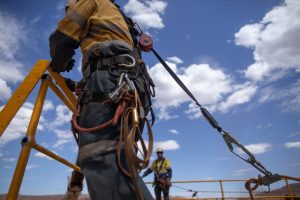The construction industry fall protection standard (29 CFR §1926.501) continues to top the list of the Occupational Safety and Health Administration’s (OSHA) most frequently cited standards for the 11th year in a row. The agency unveiled a preliminary list of violations for fiscal year (FY) 2021 in a virtual presentation at the National Safety Council’s (NSC) 2021 Safety Congress & Expo.
Fall protection was followed by the general industry respiratory protection standard (§1910.134) and construction ladders standard (§1926.1053). Hazard communication (§1910.1200), which had spent the last several years at number 2, dropped to the 5th spot on this year’s list.
“Although incredible advancements are made in safety each year, the OSHA Top 10 list reminds us that we must continue to pinpoint areas where we can improve so we can better prioritize workplace safety in the future world of work,” NSC president and CEO Lorraine Martin said in a statement.
“Throughout the pandemic, workplace safety has become more important than ever,” she continued.
The top 10 most frequently cited workplace safety and health standards for FY 2021 are:
- Fall Protection—General Requirements (§1926.501): 5,295 violations;
- Respiratory Protection (§1910.134): 2,527 violations;
- Ladders (§1926.1053): 2,026 violations;
- Scaffolding (§1926.451): 1,948 violations;
- Hazard Communication (§1910.1200): 1,947 violations;
- Lockout/Tagout (§1910.147): 1,698 violations;
- Fall Protection—Training Requirements (§1926.503): 1,666 violations;
- Personal Protective and Lifesaving Equipment—Eye and Face Protection (§1926.102): 1,452 violations;
- Powered Industrial Trucks (§1910.178): 1,420 violations; and
- Machine Guarding (1910.212): 1,113 violations.
Fiscal year vs. calendar year
FY 2021 began October 1, 2020, and ended September 30, making it the first full fiscal year impacted by the COVID-19 pandemic. Last year, California, Michigan, Oregon, and Virginia established COVID-19 emergency temporary standards (ETSs), and this year, Oregon and Virginia both issued permanent COVID-19 standards that remain in effect until repealed.
On June 10, OSHA issued a COVID-19 ETS for health care and healthcare support services—its first emergency rule since an asbestos ETS issued in 1983. The temporary rule requires employers to conduct hazard assessments and develop written plans to mitigate the spread of the virus, including the use of respirators and other personal protective equipment. On September 9, the White House announced plans for a second ETS compelling employers to require employee vaccination or conduct weekly testing for infections.
Federal and state authorities also took steps to address exposure to excessive heat and the risks of heat illnesses. On September 20, OSHA and the White House announced “enhanced and expanded efforts” to address worker exposures to excessive heat and heat-related illnesses that included launching a National Emphasis Program (NEP) and establishing the first federal workplace heat standard. OSHA already had an agencywide enforcement initiative and regional emphasis program (Region 6: Arkansas, Louisiana, Oklahoma, New Mexico, and Texas) for heat illness prevention in place.
This summer, Oregon OSHA adopted new emergency rules for the prevention of heat illness in outdoor and indoor workplaces, against high heat in employer-provided housing, and protections from the hazards of wildfire smoke.

